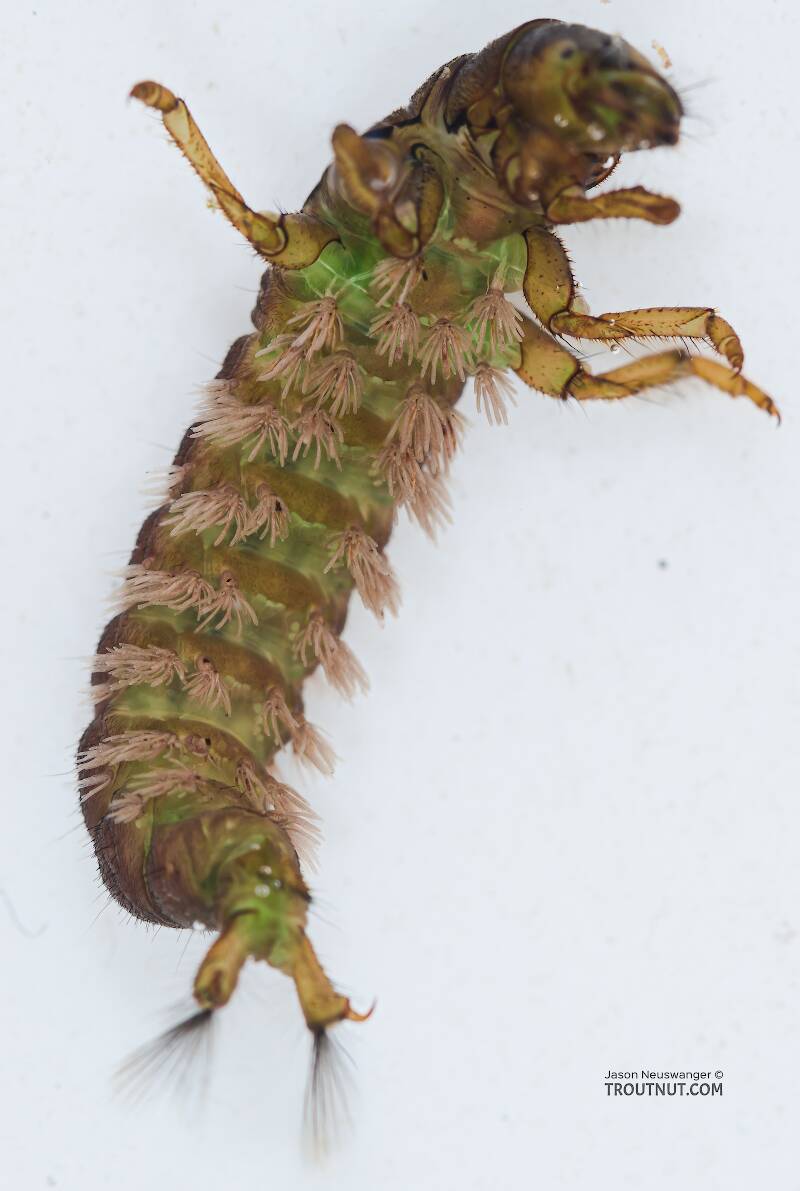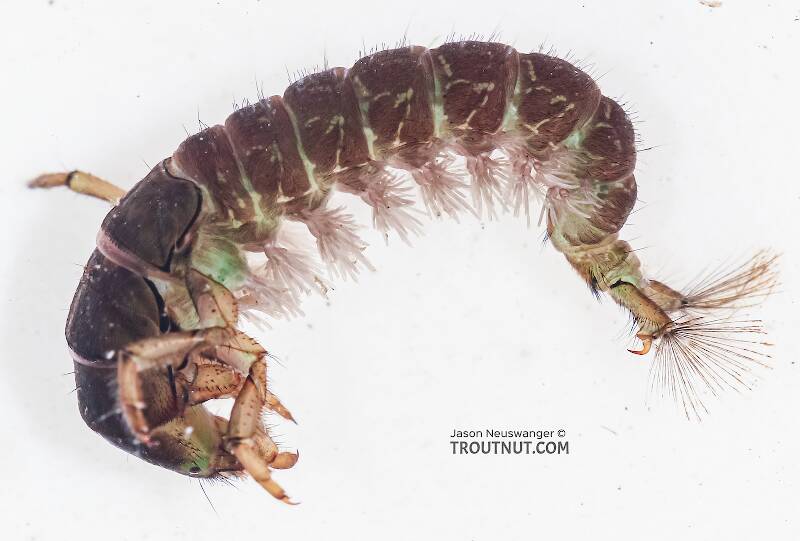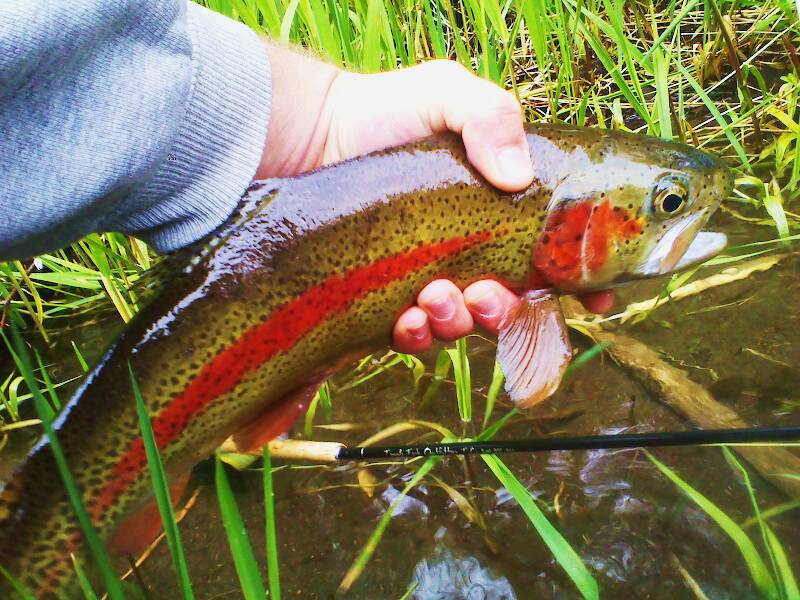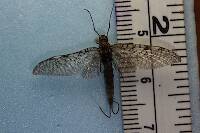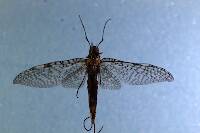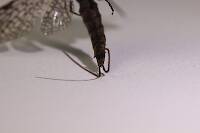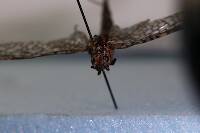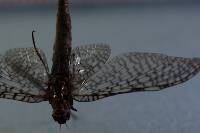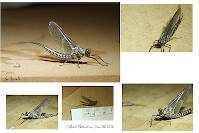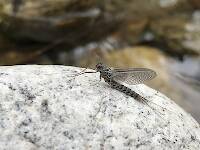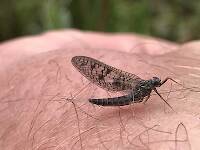
Salmonflies
Pteronarcys californica
The giant Salmonflies of the Western mountains are legendary for their proclivity to elicit consistent dry-fly action and ferocious strikes.
Featured on the forum

This specimen keys to the Epeorus albertae group of species. Of the five species in that group, the two known in Washington state are Epeorus albertae and Epeorus dulciana. Of the two, albertae has been collected in vastly more locations in Washington than dulciana, suggesting it is far more common. On that basis alone I'm tentatively putting this nymph in albertae, with the large caveat that there's no real information to rule out dulciana.

Troutnut is a project started in 2003 by salmonid ecologist Jason "Troutnut" Neuswanger to help anglers and
fly tyers unabashedly embrace the entomological side of the sport. Learn more about Troutnut or
support the project for an enhanced experience here.
This topic is about the Caddisfly Species Arctopsyche grandis
Example specimens
Flymonster on Sep 7, 2011September 7th, 2011, 9:55 pm EDT
Here in the Willamette Valley the McKenzie Caddis (as Arctopsyche grandis is known locally) usually begins its emergence sometime around mid-May and can continue into mid-June. The most emergence activity will be noted on warm days once the water temperature reaches @ 52f. Most hatches occur on warm sunny days from 4pm-7pm. Arlen Thomason goes into great detail about the life-cycle and behaviors of a. grandis in his book "Bug Water".
At least for me, the McKenzie Caddis, marks the beginning of summer and excellent fly fishing for trout on the McKenzie, Middle Fork Willamette, North Fork of the Middle Fork Willamette, and our other local rivers and streams.
At least for me, the McKenzie Caddis, marks the beginning of summer and excellent fly fishing for trout on the McKenzie, Middle Fork Willamette, North Fork of the Middle Fork Willamette, and our other local rivers and streams.
Fish or not to fish, there is no question.
ALWAYS FISH!
Dave
ALWAYS FISH!
Dave
Entoman on Sep 8, 2011September 8th, 2011, 12:23 am EDT
Thanks for the input and welcome to the forum Flymonster. What sizes, patterns do you like? How do you like to fish the hatch?
"It's not that I find fishing so important, it's just that I find all other endeavors of Man equally unimportant... And not nearly as much fun!" Robert Traver, Anatomy of a Fisherman
PaulRoberts on Apr 12, 2012April 12th, 2012, 7:12 am EDT
A. grandis is abundant in the small mountain streams I fish here in CO. But I've yet to find where they and trout actually meet. Local lore has it they are mostly nocturnal. I've tied a full compliment of life stage imitations bc they are so abundant. Some day I'll put it all together.
Entoman on Apr 12, 2012April 12th, 2012, 1:32 pm EDT
Paul -
That's my experience as well. The only place I've found them important where trout live is Rock Creek (if I remember right) and a day I once had on the upper Big Hole in Montana looking for grayling. They were both active midday.
I've heard about these big boys being important in Oregon, but I've never run into them (and I've fished there quit a bit over the years). Most hatch charts for the Mckenzie do show a large green caddis in size 8, but don't mention if they are talking larvae or adults. I have my doubts that grandis is found that low in a watershed, but I've never fished the McKenzie and was really interested to hear more of Flymonster's input. Unfortunately, it appears he was just another hit-and-run poster. :(
That's my experience as well. The only place I've found them important where trout live is Rock Creek (if I remember right) and a day I once had on the upper Big Hole in Montana looking for grayling. They were both active midday.
I've heard about these big boys being important in Oregon, but I've never run into them (and I've fished there quit a bit over the years). Most hatch charts for the Mckenzie do show a large green caddis in size 8, but don't mention if they are talking larvae or adults. I have my doubts that grandis is found that low in a watershed, but I've never fished the McKenzie and was really interested to hear more of Flymonster's input. Unfortunately, it appears he was just another hit-and-run poster. :(
"It's not that I find fishing so important, it's just that I find all other endeavors of Man equally unimportant... And not nearly as much fun!" Robert Traver, Anatomy of a Fisherman
PaulRoberts on Apr 12, 2012April 12th, 2012, 2:09 pm EDT
There was a great write-up on them not that long ago by a guy on the MacKenzie. Can't find it now. The photos showed very large water and he described details in fishing that activity.
Flymonster on May 16, 2013May 16th, 2013, 11:36 am EDT
Sorry about the post and run, and yes it has been some time. We are now seeing some emergence of A.grandis on the lower McKenzie (below Leaburg Dam all the way down). In my experience, we see more in the lower river than we do the upper river (Blue River and above) The middle McKenzie (Blue River to Leaburg Lake) there are a few but nothing like the lower river.
Typically, I'll use 8's, 10's, and 12's (10's being the go to) CDC green foam body caddis, and same size elk hair caddis with bright green bodies for dry. Karnopp's riffle diver in 10's and 12's for an emergent pupa. Many times tied off the bend of a dry @ 18-24". Warmer darker, overcast days will see the most activity during daylight hours. Also, late evening, just before dark on clear days. Once the emergence begins, it seems the trout pretty much go after them (A.grandis) with reckless abandon.
http://www.west-fly-fishing.com/forums/ubbthreads.php?ubb=showflat&Number=337785 this is a link to Arlen Thomason's write up which also appears in his book "Bug Water".
Typically, I'll use 8's, 10's, and 12's (10's being the go to) CDC green foam body caddis, and same size elk hair caddis with bright green bodies for dry. Karnopp's riffle diver in 10's and 12's for an emergent pupa. Many times tied off the bend of a dry @ 18-24". Warmer darker, overcast days will see the most activity during daylight hours. Also, late evening, just before dark on clear days. Once the emergence begins, it seems the trout pretty much go after them (A.grandis) with reckless abandon.
http://www.west-fly-fishing.com/forums/ubbthreads.php?ubb=showflat&Number=337785 this is a link to Arlen Thomason's write up which also appears in his book "Bug Water".
Fish or not to fish, there is no question.
ALWAYS FISH!
Dave
ALWAYS FISH!
Dave
Flymonster on May 20, 2013May 20th, 2013, 11:38 am EDT
Also to add to what I witnessed yesterday 5/19/13. There was a rather decent emergence of A.grandis, the most I had seen at one time over the last 5 years, taking place in the lower McKenzie from around 5pm until 7ish pm. I wasn't able to capture any of them for a photo shoot, however I did notice several still VERY green (freshly hatched) flitting about, and many others that were significantly darker(older) egg layers. It was a fairly nice afternoon in the valley and only once the shadows got long did the majority of the appearances happen. However, much of the afternoon was spent pitching a CDC foam body caddis with good success.
Fish or not to fish, there is no question.
ALWAYS FISH!
Dave
ALWAYS FISH!
Dave
Quick Reply
Related Discussions
Topic
Replies
Last Reply
1
Jan 28, 2018
by Taxon
by Taxon
5
Dec 4, 2008
by Beardius
by Beardius
4
Jun 17, 2020
by Leskorcala
by Leskorcala
Brachycentrus americanus on the Lower Sacramento River California
In the Caddisfly Species Brachycentrus americanus by Troutguide
In the Caddisfly Species Brachycentrus americanus by Troutguide
0
Oct 29, 2016
by Troutguide
by Troutguide
10
Dec 18, 2013
by Brookyman
by Brookyman
1
May 17, 2016
by Bnorikane
by Bnorikane


